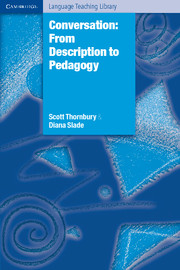Book contents
- Frontmatter
- Contents
- Thanks and acknowledgements
- Dedication
- Introduction
- 1 Characterizing conversation
- 2 The vocabulary of conversation
- 3 The grammar of conversation
- 4 The discourse features of conversation
- 5 Genres in conservation: Storytelling and gossiping
- 6 Acquiring L1 conversational competence
- 7 Acquiring L2 conversational competence
- 8 Teaching conversation: A history
- 9 Teaching conversation: Approach, design, procedure and process
- Task key
- References
- Author index
- Subject index
6 - Acquiring L1 conversational competence
Published online by Cambridge University Press: 04 May 2010
- Frontmatter
- Contents
- Thanks and acknowledgements
- Dedication
- Introduction
- 1 Characterizing conversation
- 2 The vocabulary of conversation
- 3 The grammar of conversation
- 4 The discourse features of conversation
- 5 Genres in conservation: Storytelling and gossiping
- 6 Acquiring L1 conversational competence
- 7 Acquiring L2 conversational competence
- 8 Teaching conversation: A history
- 9 Teaching conversation: Approach, design, procedure and process
- Task key
- References
- Author index
- Subject index
Summary
Introduction
In the chapters so far, we have been concerned – from various points of view – with describing conversation: how is it structured? what is its purpose? how does it differ from other ways of using language? The purpose of the description is to help inform the teaching of conversation. But a description is not a pedagogy (i.e. a way of teaching). Simply describing the rudiments of conversation to learners is likely to be about as effective as describing the rudiments of grammar – ultimately a fairly unproductive and even frustrating exercise. A pedagogy, to be fully effective, must take into account the way that conversational skills develop in a first language and the way that they respond to instruction in a second. It is the purpose of this chapter and the next, therefore, to review current theory and recent research into the acquisition of conversational competence. First, though, it is necessary to explain what we mean by conversational competence.
Conversational competence
The notion of conversational competence derives from Chomsky's (1965) distinction between competence and performance. According to Chomsky, competence is the idealized and internalized knowledge of the rules of grammar that native speakers possess, and which allows them to distinguish well-formed from ill-formed sentences. Competence contrasts with performance, which is the way that this idealized knowledge is realized, with all its ‘imperfections’, in actual speech. The concept of competence was subsequently extended by Hymes to include not just knowledge of the rules of grammar, but knowledge of ‘when to speak, when not, and … what to talk about with whom, when, where, in what manner’ (1972b: 277).
- Type
- Chapter
- Information
- ConversationFrom Description to Pedagogy, pp. 186 - 213Publisher: Cambridge University PressPrint publication year: 2006



